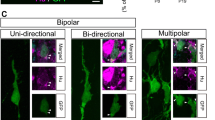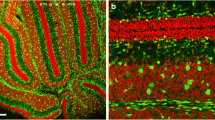Summary
The mode of neuron migration from the site of their origin in the ventricular zone to area CA1 of the hippocampus was analysed with Golgi and electron microscopic methods during the first half of gestation in the foetal rhesus monkey. In the inner portion of the intermediate zone, the migrating cells have a bipolar form with one, or occasionally two, leading processes which do not reach the ammonic plate and with a single trailing process which usually ends within the intermediate zone. Both the nucleus and the cytoplasm of the migrating cells are relatively electron-dense and the latter contains organelles typical of young neurons as described in other brain regions. Analysis of electron micrographs from serial sections reveals that the length of the somata and of the leading and trailing processes of the migrating neurons is apposed to fascicles of radially oriented, electron-lucent, microtubule-filled fibres which are ultrastructurally similar to the radial glial fibres of the neocortex and to the Bergmann glial fibres of the cerebellum. The close (20 nm) apposition between the membranes of the migrating cell and the radial fibre is maintained even in areas where the fibres bend or curve tortuously. Migrating neurons situated at progressively more superficial levels of the intermediate zone become progressively more differentiated and complex. Thus, in the outer portion of the intermediate zone, the migrating cells acquire several additional cytoplasmic processes and occasionally a long thin axon-like process which courses into the incipient alveus. These cells have somewhat larger somata and less electron-dense nuclei and cytoplasm than the migrating neurons still situated in the inner part of the intermediate zone. Cells close to the ammonic plate usually have one to three cytoplasmic processes that enter the ammonic plate and terminate near their presumed final position. Migrating neurons situated at the lower border of the ammonic plate have a single large apical process which intermingles with neurons already in their final position and which sometimes traverses the ammonic plate. The apposition of the migrating neurons to the radial glial processes becomes less explicit as the cell soma enters the ammonic plate, reflecting the more complex three-dimensional intercellular relationships. However, the present analysis indicates that during the middle and late stages of neuronal migration to the hippocampus radial glial fibres may guide postmitotic young neurons across the intermediate zone to the ammonic plate in the same way that they guide neurons migrating to the superficial and middle layers of the neocortical plate.
Similar content being viewed by others
References
Antanitus, D. S., Choi, B. H. andLapham, L. W. (1976) The demonstration of glial fibrillary acidic protein in the cerebrum of the human fetus by indirect immunofluorescence.Brain Research 103, 613–6.
Barrett, J. M., Heidger, Jr., P. M. andKennedy, S. W. (1975) Chelated bismuth as a stain in electron microscopy.Journal of Histochemistry and Cytochemistry 23, 780–83.
Bignami, A. andDahl, D. (1974a) Astrocyte-specific protein and radial glia in the cerebral cortex of newborn rat.Nature 252, 55–6.
Bignami, A. andDahl, D. (1974b) Astrocyte-specific protein and neuroglia differentiation. An immunofluorescence study with antibodies to the glial fibrillary acidic protein.Journal of Comparative Neurology 153, 27–38.
Choi, B. H. andLapham, L. W. (1978) Radial glia in the human fetal cerebrum: a combined Golgi, immunofluorescence and electron microscopic study.Brain Research 148, 295–311.
Derer, P. (1974) Histogenèse du néocortex du rat albino durant la période foetale et neonatale.Journal für Hirnforschung 15, 49–74.
Gona, A. G. (1978) Ultrastructural studies on cerebellar histogenesis in the frog: the external granular layer and molecular layer.Brain Research 153, 435–47.
Hattori, T. andFujita, S. (1974) Scanning electron microscopic studies on morphology of matrix cells, and on development and migration of neuroblasts in human and chick embryos.Journal of Electron Microscopy 23, 269–76.
His, W. (1904)Die Entwicklung des menschlichen Gehirns wahrend der ersten Monate. Leipzig: Hirzel.
Kölliker, A. (1896)Handbuch der Gewebelehre des Menschen. Vol. 2.Nervensystem des Menschen und der Tiere. Leipzig: Engelman.
Landis, D. M. D. andSidman, R. L. (1978) Electron microscopic analysis of postnatal histogenesis in the cerebellar cortex of staggerer mutant mice.Journal of Comparative Neurology 179, 831–64.
Lorente de nó, R. (1934) Studies on the structure of the cerebral cortex. II. Continuation of the study of the ammonic system.Journal für Psychologie und Neurologie 46, 113–77.
Manasek, F. J. (1968) Myocardial cell death in the embryonic, chick ventricle.Journal of Embryology and Experimental Morphology 21, 271–84.
Morest, D. K. (1970) A study of neurogenesis in the forebrain of opossum pouch young.Zeitschrift für Anatomie und Entwicklungsgeschichte 130, 265–305.
Mugnaini, E. andForstrønen, P. F. (1967) Ultrastructural studies on the cerebellar histogenesis. I. Differentiation of granule cells and development of glomeruli in the chick embryo.Zeitschrift für Zellforschung und mikroskopische Anatomie 77, 115–43.
Nowakowski, R. S. andRakic, P. (1980) The site of origin and route and rate of migration of neurons in the hippocampal region of the rhesus monkey.Journal of Comparative Neurology (in press).
Peters, A. andFeldman, M. (1973) The cortical plate and molecular layer of the late rate fetus.Zeitschrift für Anatomie und Entwicklungsgeschichte 141, 3–37.
Pouwels, E. (1978) On the development of the cerebellum of the trout,Salmo gairdeneri. V. Neuroglial cell development.Anatomy and Embryology 3, 67–83.
Rakic, P. (1971a) Neuron-glia relationship during granule cell migration in developing cerebellar cortex. A Golgi and electronmicroscopic study inMacacus rhesus.Journal of Comparative Neurology 141, 283–312.
Rakic, P. (1971b) Guidance of neurons migrating to the foetal monkey neocortex.Brian Research 33, 471–6.
Rakic, P. (1972) Mode of cell migration to the superficial layers of foetal monkey neocortex.Journal of Comparative Neurology 145, 61–83.
Rakic, P. (1975) Timing of major ontogenetic events in the visual cortex of the rhesus monkey. InBrain Mechanisms in Mental Retardation (edited byBregsma, D.), Birth Defects: Original Series, Vol. 9, pp. 95–129. New York: Liss.
Rakic, P. (1978) Neuronal migration and contact guidance in primate telencephalon.Postgraduate Medical Journal 54, 25–40.
Rakic, P. andNowakowski, R. S. (1980) The time of origin of neurons in the hippocampal region of the rhesus monkey.Journal of Comparative Neurology (in press).
Rakic, P. andSidman, R. L. (1973) Sequence of developmental abnormalities leading to granule cell deficit in cerebellar cortex of weaver mutant mice.Journal of Comparative Neurology 152, 103–32.
Rakic, P., Stensaas, L. J., Sayre, E. P. andSidman, R. L. (1974) Computer aided three-dimensional reconstruction and quantitative analysis of cells from serial electron microscopic montages of foetal monkey brain.Nature 250, 31–4.
Ramón, Y. Cajal, S. (1893) Estructura del asta de Ammon y fascia dentada.Anales de la Sociedad Española de Historia Natural 22, 53–114. (Translated in 1968 as:The Structure of Ammon's Horn byKraft, L. M. Springfield: Thomas).
Ramón, Y. Cajal, S. (1911)Histologie de Système Nerveux de l'Homme et de Vertébrés (Translated byAzoulay, L.), Paris: Maloine.
Ramón, Y. Cajal, S. (1929)Études sur la Neurogenèse de quelques Vertébrés Madrid. (Translated in 1960 as:Studies on Vertebrate Neurogenesis,Guth, L. Springfield: Thomas).
Retzius, G. (1893) Studien über Ependym und Neuroglia.Biologische Untersuchungen (Stockholm) 5, 9–26.
Schmechel, D. E. andRakic, P. (1973) Evolution of radial glial cells in developing rhesus monkey telencephalon: A Golgi study.Anatomical Record 175, 436 (Abstract).
Schmechel, D. E. andRakic, P. (1979a) Arrested proliferation of radial glial cells during midgestation in rhesus monkey.Nature 277, 303–5.
Schmechel, D. E. andRakic, P. (1979b) A Golgi study of radial glial cells in developing monkey telencephalon: morphogenesis and transformation into astrocytes.Anatomy and Embryology 156, 115–52.
Shoukimas, G. M. andHinds, J. W. (1978) The development of the cerebral cortex in the embryonic mouse: an electron microscopic serial section analysis.Journal of Comparative Neurology 179, 795–830.
Sidman, R. L. andRakic, P. (1973) Neuronal migration, with special reference to developing human brain: a review.Brain Research 62, 1–35.
Somjen, G. G. andVaron, S. S. (1979) Neuron-glia interaction.Neurosciences Research Program Bulletin 17, 1–239.
Stensaas, L. J. (1967a) The development of hippocampal and dorsolateral pallial regions of the cerebral hemisphere in foetal rabbits. I. Fifteen millimeter stage, spongioblast morphology.Journal of Comparative Neurology 129, 59–70.
Stensaas, L. J. (1967b) The development of hippocampal and dorsolateral pallial regions of the cerebral hemisphere in foetal rabbits. II. Twenty millimeter stage, neuroblast morphology.Journal of Comparative Neurology 129, 71–84.
Stensaas, L. J. (1967c) The development of hippocampal and dorsolateral pallial regions of the cerebral hemisphere in foetal rabbits. III. Twenty-nine millimeter stage, marginal lamina.Journal of Comparative Neurology 130, 149–62.
Stensaas, L. J. (1967d) The development of hippocampal and dorsolateral pallial regions of the cerebral hemisphere in foetal rabbits. IV. Forty-one millimeter stage, intermediate lamina.Journal of Comparative Neurology 131, 409–22.
Stensaas, L. J. (1967e) The development of hippocampal and dorsolateral pallial regions of the cerebral hemisphere foetal rabbits. V. Sixty millimeter stage, glial cell morphology.Journal of Comparative Neurology 131, 423–36.
Stensaas, L. J. (1968) The development of hippocampal and dorsolateral pallial regions of the cerebral hemisphere in foetal rabbits. VI. Ninety millimeter stage, cortical differentiation.Journal of Comparative Neurology 132, 93–108.
Stensaas, L. J. andStensaas, S. S. (1968) An electron microscope study of cells in the matrix and intermediate laminae of the cerebral hemisphere of the 45 mm rabbit embryo.Zeitschrift für Zellforschung und mikroskopische Anatomie 91, 341–65.
Zecevic, N. andRakic, P. (1976) Differentiation of Purkinje cells and their relationship to other components of developing cerebellar cortex in man.Journal of Comparative Neurology 167, 27–48.
Author information
Authors and Affiliations
Additional information
The recommendations of the Boulder Committee (Anatomical Record 166, 257–61, 1970) have been followed for the nomenclature of the cardinal embryonic zones.
Rights and permissions
About this article
Cite this article
Nowakowski, R.S., Rakic, P. The mode of migration of neurons to the hippocampus: a Golgi and electron microscopic analysis in foetal rhesus monkey. J Neurocytol 8, 697–718 (1979). https://doi.org/10.1007/BF01206671
Received:
Revised:
Accepted:
Issue Date:
DOI: https://doi.org/10.1007/BF01206671




